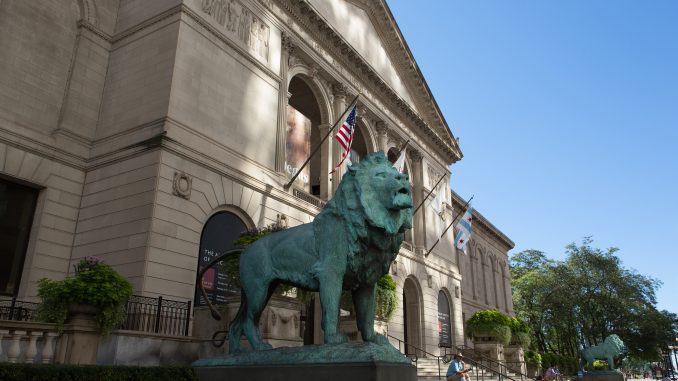
Weaving beyond the Bauhaus opened at the Art Institute of Chicago on August 3, 2019 and will be on view until February 16, 2020, Focused, fascinating and impactful, the exhibit is easy to explore in a short time, and very rewarding. Events highlighting Bauhaus at 100 are taking place worldwide, and Chicago and the Art Institute were a part of the New Bauhaus movement. Established in 1919, this acclaimed German art school the Bauhaus included an innovative weaving workshop whose influence spread across the Atlantic.

Before entering the exhibit, I knew little about the weaving workshop and the women who participated. While the names were initially unfamiliar, by the end of the exhibit, the names and works became familiar and the final works were breathtaking. The Bauhaus program that began in 1919 and disbanded in 1933, but Bauhaus had a wide-reaching impact on American art, at least on part ,due to the large number of affiliated artists who immigrated to the US, where they continued to practice and teach in the spirit of the school’s educational system and theories.

Viewing Weaving beyond the Bauhaus I was fascinated to learn that the work of the Bauhaus artists, or Bauhäusler spread when Anni Albers and Marli Ehrman, developed reciprocal relationships with fellow artists and students across America. It was their ties to arts education institutions, including Black Mountain College, the Institute of Design, the Illinois Institute of Technology, and Yale University, that allowed these artists to share their knowledge and experiences with contemporary and successive generations of artists, including Sheila Hicks, Else Regensteiner, Ethel Stein, Lenore Tawney, and Claire Zeisler, that resulted in their shaping the landscape of American art.

The exhibit began with woven fabrics that looked like woven fabrics used for clothing and upholstery. There was a change in look and function as the fabrics became integral with the work of architects, modifying light from windows. Works developed as art pieces, standing sculpture, wall hangings and suspended pieces. Works are dramatic, beautiful and compelling.


I spoke with Samantha Jones who was on duty in this space and asked if working there was fun. She said, “It depends. But tin this exhibit, I can feel the energy? My friends and I agreed completely. Knowing that Bauhaus celebrations are taking place in so many places, abut especially in Germany, I was pleased the Art Institute is highlighting the role of Chicago and the Art Institute itself in this movement. More information about Bauhaus in Chicago. More about Bauhaus in Germany

Stepping into the hall outside the weaving exhibit, my companion and I noticed an exhibit of exquisite jewelry. The Ornamental Traditions: Jewelry from Bukhara displays 50 jeweled objects from the Central Asian region of Bukhara along with the rare ikat and embroidered textiles from the Art Institute’s permanent collection. The work is elaborate and unlike works I have seen. The earrings were so large, we wondered how one could wear them and keep balanced. Read more about this exhibit


After a visit to the familiar gallery housing the Chagall windows and maquettes of sculptures around the City of Chicago and the Museum Shop we left.

planning to return for the next major exhibit opening.

Be the first to comment